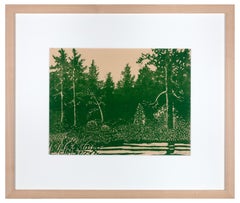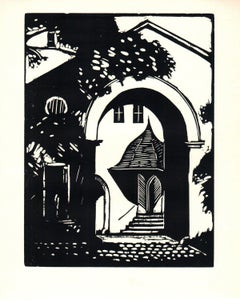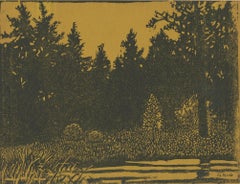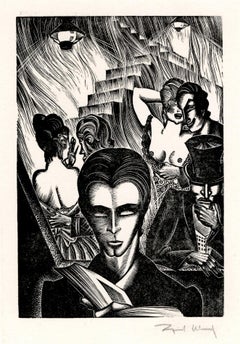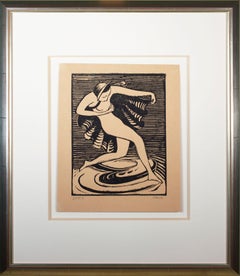George Raab Prints and Multiples
1
to
3
1
2
2
1
2
1
Overall Height
to
Overall Width
to
1
2
2
2
2
1
1
1
3
1
4
1,003
725
670
630
2
1
Artist: George Raab
"Solitude, " Linoleum Block Print, Signed
By George Raab
Located in Milwaukee, WI
"Solitude" is an original linoleum block print by George Raab. It is signed in the lower right and titled. It depicts a treeline and other forest ...
Category
20th Century George Raab Prints and Multiples
Materials
Linocut
1939 George Raab 'Portal in Weimar'
By George Raab
Located in Brooklyn, NY
Paper Size: 9.25 x 9 inches ( 23.495 x 22.86 cm )
Image Size: 8 x 6 inches ( 20.32 x 15.24 cm )
Framed: No
Condition: A: Mint
Additional Details: This piece derives from the 19...
Category
1930s American Modern George Raab Prints and Multiples
Materials
Woodcut
"Forest Primeval, " Linoleum Block Print signed by George Raab
By George Raab
Located in Milwaukee, WI
"Forest Primeval" is an original linoleum block print by George Raab. It is signed in the lower right and titled. It depicts a treeline on a dark yellow ochre background.
9" x 12" art
Born 1866 in Sheboygan, Wisconsin
Died 1943 in Milwaukee, Wisconsin
George Raab began his art studies around 1890 in Milwaukee under Richard Lorenz and Robert Schade at the Wisconsin Art Institute. In 1889 he and partner Herman Feiker set up the photographic studio of Feiker and Raab. A year later he was listed in the Milwaukee City Directory under Raab and Bressler, Crayon Artists. It is presumed that from 1891–1896, upon Lorenz's advice, Raab resumed his studies in Germany at the Weimar Art...
Category
20th Century George Raab Prints and Multiples
Materials
Linocut
Related Items
"Little Landscape on the High Seas", abstract print, signed and numbered 41/200
By Dieter Roth
Located in Cologne, DE
Dieter Roth (1930-1998) was born in Hannover, Germany and grew up in Zürich, Switzerland. He started an apprenticeship as an advertising graphic designer and took private lessons in ...
Category
Late 20th Century Post-War George Raab Prints and Multiples
Materials
Linocut, Black and White
'Madman's Drum (Plate 41)' — 1930s Graphic Modernism
By Lynd Ward
Located in Myrtle Beach, SC
Lynd Ward, 'Madman's Drum, Plate 41', wood engraving, 1930, edition small. Signed in pencil. A fine, black impression, on off-white tissue-thin Japan paper; the full sheet with margins (1 5/8 to 2 1/2 inches); a small paper blemish in the upper right margin, away from the image, otherwise in excellent condition. Scarce. Matted to museum standards, unframed.
Image size 5 1/2 x 3 3/4 inches (140 x 95 mm); sheet size 9 5/8 x 7 1/8 inches (244 x 181 mm).
From Lynd Ward’s book of illustrations without words, 'Madman’s Drum', Jonathan Cape and Harrison Smith, New York, 1930. Illustrated in 'Storyteller Without Words: The Wood Engravings of Lynd Ward', Harry Abrams, New York, 1974.
Reproduced in 'Storyteller Without Words, the Wood Engravings of Lynd Ward', Harry N. Abrams, New York, 1974.
ABOUT THE ARTIST
Lynd Ward is acknowledged as one of America’s foremost wood engravers and book illustrators of the first half of the twentieth century. His innovative use of narrative printmaking as a stand-alone storytelling vehicle was uniquely successful in reaching a broad audience. The powerful psychological intensity of his work, celebrated for its dynamic design, technical precision, and compelling dramatic content, finds resonance in the literature of Poe, Melville, and Hawthorne. Like these classic American writers, Ward was concerned with the themes of man’s inner struggles and the role of the subconscious in determining his destiny. An artist of social conscience during the Great Depression and World War II, he infused his graphic images with his unique brand of social realism, deftly portraying the problems that challenged the ideals of American society.
The son of a Methodist preacher, Lynd Ward, moved from Chicago to Massachusetts at an early age. He graduated from the Teachers College of Columbia University, New York, in 1926, where he studied illustration and graphic arts. He married May Yonge McNeer in 1936 and left for Europe for their honeymoon in Eastern Europe. After four months, they settled in Leipzig, where Ward studied at the National Academy of Graphic Arts and Bookmaking. Inspired by Belgian expressionist artist Frans Masereel's graphic novel ‘The Sun,’ and another graphic novel by the German artist Otto Nückel, ‘Destiny,’ he determined to create his own "wordless" novel. Upon his return to America, Ward completed his first book, ‘God's Man: A Novel in Woodcuts,’ published in 1929. ‘Gods’ Man’ was a great success for its author and publisher and was reprinted four times in 1930, including a British edition. This book and several which followed it, ‘Madman’s Drum,’ 1930, ‘Wild Pilgrimage...
Category
1930s American Modern George Raab Prints and Multiples
Materials
Woodcut
'Simplicius' Farewell to the World' — Graphic Modernism
By Fritz Eichenberg
Located in Myrtle Beach, SC
Fritz Eichenberg, 'Simplicius’ Farewell To The World' from the suite 'The Adventurous Simplicissimus', wood engraving, 1977, artist's proof apart from the edition of 50. Signed in pencil. Signed in the block, lower right. A fine, richly-inked impression, on cream wove paper, with full margins (1 1/2 to 2 inches), in excellent condition. Image size 14 x 12 inches (356 x 305 mm); sheet size 17 1/2 x 15 inches (445 x 381 mm). Archivally sleeved, unmatted.
ABOUT THIS WORK
'Simplicius Simplicissimus' (German: Der abenteuerliche Simplicissimus Teutsch) is a picaresque novel of the lower Baroque style, written in five books by Hans Jakob Christoffel von Grimmelshausen published in 1668, with the sequel Continuatio appearing in 1669.
The novel is told from the perspective of its protagonist Simplicius, a rogue or picaro typical of the picaresque novel, as he traverses the tumultuous world of the Holy Roman Empire during the Thirty Years' War. Raised by a peasant family, he is separated from his home by foraging dragoons. He is adopted by a hermit living in the forest, who teaches him to read and introduces him to religion. The hermit also gives Simplicius his name because he is so simple that he does not know his own name. After the death of the hermit, Simplicius must fend for himself. He is conscripted at a young age into service and, from there, embarks on years of foraging, military triumph, wealth, prostitution, disease, bourgeois domestic life, and travels to Russia, France, and an alternate world inhabited by mermen. The novel ends with Simplicius turning to a life of hermitage, denouncing the world as corrupt.
ABOUT THE ARTIST
Fritz Eichenberg (1901–1990) was a German-American illustrator and arts educator who worked primarily in wood engraving. His best-known works were concerned with religion, social justice, and nonviolence.
Eichenberg was born to a Jewish family in Cologne, Germany, where the destruction of World War I helped to shape his anti-war sentiments. He worked as a printer's apprentice and studied at the Municipal School of Applied Arts in Cologne and the Academy of Graphic Arts in Leipzig, where he studied under Hugo Steiner-Prag. In 1923 he moved to Berlin to begin his career as an artist, producing illustrations for books and newspapers. In his newspaper and magazine work, Eichenberg was politically outspoken and sometimes wrote and illustrated his reporting.
In 1933, the rise of Adolf Hitler drove Eichenberg, who was a public critic of the Nazis, to emigrate with his wife and children to the United States. He settled in New York City, where he lived most of his life. He worked in the WPA Federal Arts Project and was a member of the Society of American Graphic Artists.
In his prolific career as a book illustrator, Eichenberg portrayed many forms of literature but specialized in works with elements of extreme spiritual and emotional conflict, fantasy, or social satire. Over his long career, Eichenberg was commissioned to illustrate more than 100 classics by publishers in the United States and abroad, including works by renowned authors Dostoyevsky, Tolstoy, Charlotte and Emily Brontë, Poe, Swift, and Grimmelshausen. He also wrote and illustrated books of folklore and children's stories.
Eichenberg was a long-time contributor to the progressive magazine The Nation, his illustrations appearing between 1930 and 1980. Eichenberg’s work has been featured by such esteemed publishers as The Heritage Club, Random House, Book of the Month Club, The Limited Editions Club, Kingsport Press, Aquarius Press, and Doubleday.
Raised in a non-religious family, Eichenberg had been attracted to Taoism as a child. Following his wife's unexpected death in 1937, he turned briefly to Zen Buddhist meditation, then joined the Religious Society of Friends in 1940. Though he remained a Quaker until his death, Eichenberg was also associated with Catholic charity work through his friendship with Dorothy Day...
Category
1970s American Modern George Raab Prints and Multiples
Materials
Woodcut
Hendrik Glintenkamp, (Farmyard)
By Hendrik Glintenkamp
Located in New York, NY
More a wood engraving rather than a woodcut, Glintenkamp's Farmyard scene was given all the care and detail of the artist's more complex images. It is signed and numbered in pencil. ...
Category
1920s American Modern George Raab Prints and Multiples
Materials
Woodcut
'The Pimp' — Graphic Modernism
By Fritz Eichenberg
Located in Myrtle Beach, SC
Fritz Eichenberg, 'The Pimp', wood engraving, 1980, artist's proof before the edition. Signed in pencil. Signed in the block, lower right. A fine, richly-inked impression, on cream wove paper, with full margins (2 3/16 to 3 1/2 inches), in excellent condition. Archivally sleeved, unmatted.
Image size 12 x 9 3/4 inches (305 x 248 mm); sheet size 18 x 14 inches (457 x 356 mm).
ABOUT THE ARTIST
Fritz Eichenberg (1901–1990) was a German-American illustrator and arts educator who worked primarily in wood engraving. His best-known works were concerned with religion, social justice, and nonviolence.
Eichenberg was born to a Jewish family in Cologne, Germany, where the destruction of World War I helped to shape his anti-war sentiments. He worked as a printer's apprentice and studied at the Municipal School of Applied Arts in Cologne and the Academy of Graphic Arts in Leipzig, where he studied under Hugo Steiner-Prag. In 1923 he moved to Berlin to begin his career as an artist, producing illustrations for books and newspapers. In his newspaper and magazine work, Eichenberg was politically outspoken and sometimes wrote and illustrated his reporting.
In 1933, the rise of Adolf Hitler drove Eichenberg, who was a public critic of the Nazis, to emigrate with his wife and children to the United States. He settled in New York City, where he lived most of his life. He worked in the WPA Federal Arts Project and was a member of the Society of American Graphic Artists.
In his prolific career as a book illustrator, Eichenberg portrayed many forms of literature but specialized in works with elements of extreme spiritual and emotional conflict, fantasy, or social satire. Over his long career, Eichenberg was commissioned to illustrate more than 100 classics by publishers in the United States and abroad, including works by renowned authors Dostoyevsky, Tolstoy, Charlotte and Emily Brontë, Poe, Swift, and Grimmelshausen. He also wrote and illustrated books of folklore and children's stories.
Eichenberg was a long-time contributor to the progressive magazine The Nation, his illustrations appearing between 1930 and 1980. Eichenberg’s work has been featured by such esteemed publishers as The Heritage Club, Random House, Book of the Month Club, The Limited Editions Club, Kingsport Press, Aquarius Press, and Doubleday.
Raised in a non-religious family, Eichenberg had been attracted to Taoism as a child. Following his wife's unexpected death in 1937, he turned briefly to Zen Buddhist meditation, then joined the Religious Society of Friends in 1940. Though he remained a Quaker until his death, Eichenberg was also associated with Catholic charity work through his friendship with Dorothy Day...
Category
1980s American Modern George Raab Prints and Multiples
Materials
Woodcut
Dan Burne Jones, Affection
Located in New York, NY
Dan Burne Jones is widely know as the author of the Rockwell Kent print catalogue raisonne. It's so interesting to see that he is a gifted wood engraver as well. Jones's own prints a...
Category
1930s American Modern George Raab Prints and Multiples
Materials
Woodcut
Modern American Industrial Landscape
Located in Buffalo, NY
An original woodblock print dated 1965, titled "Our Town" but signed illegibly.
Category
1960s American Modern George Raab Prints and Multiples
Materials
Woodcut, Paper
Henry Spanner, Beer
Located in New York, NY
This is among the very few prints known by Spanner. It's the epitome of joie de vivre. It is signed, numbered, and annotated 'Hand print,' in pencil. The numbering indicates an edit...
Category
1930s American Modern George Raab Prints and Multiples
Materials
Woodcut
'The Bather' — 1930s American Modernism
By Rockwell Kent
Located in Myrtle Beach, SC
Rockwell Kent, 'The Bather', wood engraving, 1931, edition 120, Burne Jones 63. Signed in pencil. A brilliant, black impression, on cream, wove Japan paper; the full sheet with margins (2 1/2 to 3 1/4 inches); slight skinning at the top sheet edge, verso, otherwise in excellent condition. Image size 5 3/8 x 7 7/8 inches (137 x 200 mm); sheet size 11 1/8 x 14 1/2 inches (283 x 368 mm). Archivally matted to museum standards, unframed.
Impressions of this work are held in the following public collections: Burne Jones Collection, IL; Chegodaev Collection, Moscow; Kent Collection, NY; Philadelphia Museum of Art; Princeton University Library, NJ; Pushkin Museum, Moscow; Smithsonian American Art Museum, Spector Collection, NY.
Rockwell Kent (1882-1971), though best known as a painter, graphic artist, and illustrator, pursued many careers throughout his life, including architect, carpenter, explorer, writer, dairy farmer, and political activist. Born in Tarrytown, New York, Kent was interested in art from a young age. These ambitions were encouraged by his aunt Jo Holgate, an accomplished ceramicist. Jo came to live with the family after Kent’s father passed away in 1887 and took him to Europe as a teenager, undoubtedly kindling his interest in exploring the world.
Kent attended the Horace Mann School in New York City, where he excelled at mechanical drawing. His family’s financial circumstances prevented him from pursuing a career in the fine arts; however, after graduating from Horace Mann in 1900, Kent decided to study architecture at Columbia University.
Before matriculating at Columbia, Kent spent the first of three consecutive summers studying painting at William Merritt Chase’s art school in Shinnecock Hills, Long Island. There he found a community of mentors and fellow students who encouraged him to pursue his interest in art. At the end of Kent’s third summer at Shinnecock, Chase offered him a full scholarship to the New York School of Art, where he was a teacher. Kent began taking night classes at the art school in addition to his architecture studies but soon left Columbia to study painting full-time. In addition to Chase, Kent took classes with Robert Henri and Kenneth Hayes Miller, where his classmates included the artists George Bellows and Edward Hopper.
Kent spent the summer of 1903 assisting the eccentric painter Abbott Handerson Thayer at his studio in Dublin, New Hampshire—a position he secured through the recommendation of his Aunt Jo. Thayer’s naturalist lifestyle and almost mystical appreciation for natural phenomena greatly influenced Kent; he returned to Dublin for many years to visit Thayer and his family. Thayer gave the young artist time to pursue his work, and that summer Kent painted several views of the New Hampshire landscape, including Mount Monadnock...
Category
1930s American Modern George Raab Prints and Multiples
Materials
Woodcut
A. Ross Pittman, Summer Home
Located in New York, NY
This print is signed and titled in pencil. A native of Tennessee and a physician, Pittman began to make prints in 1936 in Trenton, New Jersey. However, scene of his home state remain...
Category
1930s American Modern George Raab Prints and Multiples
Materials
Woodcut
'City Lights' — Vintage Wood Engraving, New York City, 1934
By Fritz Eichenberg
Located in Myrtle Beach, SC
Fritz Eichenberg, 'City LIghts', wood engraving, 1934, edition 200. Signed, titled 'Lights', and annotated 'No 2/200 for Howard M. Chapin' in pencil. Initialed in the block, lower right. A fine, richly-inked black impression, on cream wove paper, with full margins (1 1/4 to 1 7/8 inches); a small loss (5/8 inch) in the top right sheet corner, well away from the image, otherwise in excellent condition. Printed by master printer Ernest Roth...
Category
1930s American Modern George Raab Prints and Multiples
Materials
Woodcut
Hill Flight, Limited Edition Linocut, Landscape Print, Rural hills, Birds, Warm
By Rob Barnes
Located in Deddington, GB
THIS IS THE VERY LAST PRINT AVAILABLE.
"Occasionally I find a view that has a great sense of distance. In this linocut I was trying to capture a sense of the rural scene. It is view...
Category
2010s Contemporary George Raab Prints and Multiples
Materials
Paper, Linocut
H 19.3 in W 24.02 in D 0.04 in
Previously Available Items
'Dance' Original Linoleum Block Print by George Raab
By George Raab
Located in Milwaukee, WI
Art: 11" x 9"
Frame: 20.5" x 17.5"
Signed and titled in the lower margin.
Framed to conservation standards. Inlaid in a bold cream matting with a tan bevel accent and glazed in Muse...
Category
1930s George Raab Prints and Multiples
Materials
Linocut
'The Pines' & 'Snow Fall' Landscape Linoleum Block Print signed by George Raab
By George Raab
Located in Milwaukee, WI
"The Pines" is an original linoleum block print by George Raab. It is signed in the lower right. This piece depicts the view from a forest to the shoreline of a lake.
Linoleum block print
9 x 12 inches, art
17.625 x 21.625 inches, frame
Signed in lower right
Framed to conservation standards using archival materials including 100 percent rag matting with 1/4 inch bevel, Museum Glass to inhibit fading and reduce glare, and housed in a silver finish wood moulding.
"Snow Fall" is an original linoleum block print by George Raab. The piece is signed in the lower right and titled in the lower left. It depicts falling snow on residential rooftops.
Linoleum block print
10.5 x 9 inches, art
20.875 x 17.625 inches, frame
Signed in lower right, titled in lower left
¼” bevel, Museum glass, silver finish
Framed to conservation standards using archival materials including 100 percent rag matting with 1/4 inch bevel, Museum Glass to inhibit fading and reduce glare, and housed in a silver finish wood moulding.
Born 1866 in Sheboygan, Wisconsin
Died 1943 in Milwaukee, Wisconsin
George Raab began his art studies around 1890 in Milwaukee under Richard Lorenz and Robert Schade at the Wisconsin Art Institute. In 1889 he and partner Herman Feiker set up the photographic studio of Feiker and Raab. A year later he was listed in the Milwaukee City Directory under Raab and Bressler, Crayon Artists. It is presumed that from 1891–1896, upon Lorenz's advice, Raab resumed his studies in Germany at the Weimar Art...
Category
20th Century George Raab Prints and Multiples
Materials
Linocut
"Snow Fall, " Linoleum Block Print of a House in Snow signed by George Raab
By George Raab
Located in Milwaukee, WI
"Snow Fall" is an original linoleum block print by George Raab. The piece is signed in the lower right and titled. It depicts falling snow on residential rooftops.
10 1/2" x 9" art
Born 1866 in Sheboygan, Wisconsin
Died 1943 in Milwaukee, Wisconsin
George Raab began his art studies around 1890 in Milwaukee under Richard Lorenz and Robert Schade at the Wisconsin Art Institute. In 1889 he and partner Herman Feiker set up the photographic studio of Feiker and Raab. A year later he was listed in the Milwaukee City Directory under Raab and Bressler, Crayon Artists. It is presumed that from 1891–1896, upon Lorenz's advice, Raab resumed his studies in Germany at the Weimar Art...
Category
20th Century Other Art Style George Raab Prints and Multiples
Materials
Linocut
George Raab prints and multiples for sale on 1stDibs.
Find a wide variety of authentic George Raab prints and multiples available for sale on 1stDibs. You can also browse by medium to find art by George Raab in linocut, woodcut print and more. Not every interior allows for large George Raab prints and multiples, so small editions measuring 9 inches across are available. Customers who are interested in this artist might also find the work of Frank Licsko, Leon Danchin, and John Edward Costigan. George Raab prints and multiples prices can differ depending upon medium, time period and other attributes. On 1stDibs, the price for these items starts at $300 and tops out at $1,620, while the average work can sell for $1,290.
